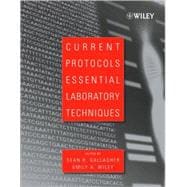
What is included with this book?
Sean R. Gallagher, Ph.D. is the Vice President and Chief Technology Officer for UVP, LLC (Upland, CA), where he oversees applied technology and product development for specialty light source and life science imaging products. He is on the corporate advisory councils of the Keck Graduate Institute of Applied Life Sciences and Harvey Mudd College (Claremont, CA) and has eight patents on technologies he has codeveloped. He received his doctorate in Botany from the University of California at Riverside and completed a post-doctoral position at Stanford University.
Emily A. Wiley, Ph.D. is an Assistant Professor in the Joint Science Department of Claremont McKenna, Pitzer, and Scripps Colleges (Claremont, CA), where she is actively involved in teaching undergraduate laboratory-intensive courses and mentoring students in original research. She received her doctorate in the area of molecular genetics from the University of Washington and held postdoctoral research positions at the University of Rochester and at The Fred Hutchinson Cancer Research Center in Seattle She maintains an active research program studying chromatin assembly and modification in Tetrahymena thermophila, which serves the dual function of providing undergraduates the opportunity to engage in modern life science.
Preface.
Contributors.
Common Conversion Factors.
Combining Techniques to Answer Molecular Questions.
Chapter 1: Volume/Weight Measurement.
1.1 Volume Measurement.
1.2 Weight Measurement.
Chapter 2: Concentration Measurement.
2.1 Spectrophotometry.
2.2 Quantitation of Nucleic Acids and Proteins.
2.3 Radiation Safety and Measurement.
Chapter 3: Reagent Preparation.
3.1 Reagent Preparation: Theoretical and Practical Discussions.
3.2 Measurement of pH.
3.3 Recipes for Commonly Encountered Reagents.
Chapter 4: Cell Culture Techniques.
4.1 Aseptic Technique.
4.2 Culture of Escherichia coli and Related Bacteria.
Chapter 5: Sample Preparation.
5.1 Centrifugation.
5.2 Purification and Concentration of Nucleic Acids.
Chapter 6: Chromatography.
6.1 Overview of Chromatography.
6.2 Column Chromatography.
Chapter 7: Electrophoresis.
7.1 Overview of Electrophoresis.
7.2 Agarose Gel Electrophoresis.
7.3 SDS-Polyacrylamide Gel Electrophoresis (SDS-PAGE).
7.4 Staining Proteins in Gels.
7.5 Overview of Digital Electrophoresis Analysis.
Chapter 8: Blotting.
8.1 Overview of Blotting.
8.2 Nucleic Acid Blotting: Southern and Northern.
8.3 Protein Blotting: Immunoblotting.
8.4 Labeling DNA and Preparing Probes.
Chapter 9: Microscopy.
9.1 Conventional Light Microscopy.
9.2 Immunofluorescence Microscopy.
Chapter 10: Enzymatic Reactions.
10.1 Working with Enzymes.
10.2 Overview of PCR.
10.3 Real-Time PCR.
10.4 DNA Sequencing: An Outsourcing Guide.
Appendices.
A.1 Laboratory Safety.
A.2 Laboratory Notebooks and Data Storage.
A.3A Ethical Considerations When Altering Digital Images.
A.3B Practical Considerations When Altering Digital Images.
A.4 Statistical Analysis.
A.5A Preparing and Presenting a Poster.
A.5B Preparing and Presenting a Talk.
Index.
The New copy of this book will include any supplemental materials advertised. Please check the title of the book to determine if it should include any access cards, study guides, lab manuals, CDs, etc.
The Used, Rental and eBook copies of this book are not guaranteed to include any supplemental materials. Typically, only the book itself is included. This is true even if the title states it includes any access cards, study guides, lab manuals, CDs, etc.